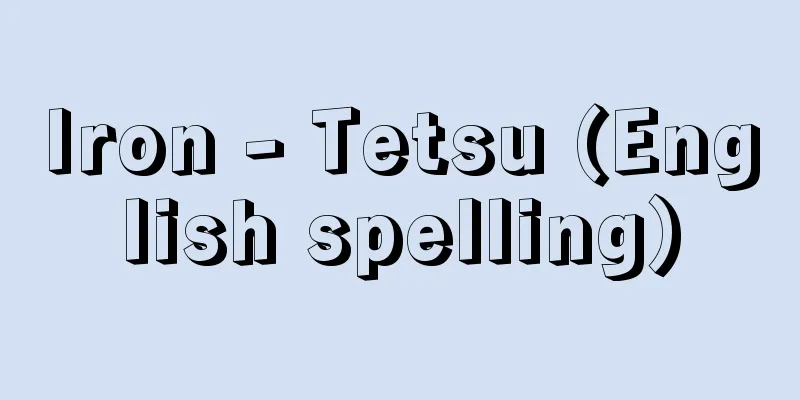Iron - Tetsu (English spelling)

|
It belongs to Group VIII of the periodic table and is one of the iron group elements. Its symbol Fe is taken from the Latin ferrum, but its origin is unclear. Its English name is said to be derived from the Latin aes (ore). In ancient Japan it was called kuro-gane (black gold), one of the five colors of gold (kogane = gold, shirogane = silver, akagane = copper, kuro-gane = iron, aogane = lead). In the past it was written with the character "tetsu" (iron), which means "king of gold," indicating that it was the most useful element in daily life. [Torii Yasuo] ExistenceIron is one of the most abundant elements in the Earth's crust, second only to aluminum among metallic elements. However, since the Earth's interior is estimated to be mainly composed of iron, its abundance on Earth as a whole is extremely high. It is chemically active and rarely exists in its pure form in nature, but occurs in deposits in the form of oxides and carbonates. The main ores are magnetite (Fe 3 O 4 ) , hematite (Fe 2 O 3 ) , limonite (Fe 2 O 3.xH 2 O), and siderite (FeCO 3 ). Iron sand is fine-grained magnetite produced by the weathering of rocks, and was previously an important iron resource. In recent years, China has been the world's largest producer of iron ore, followed by Brazil, Australia, India, Russia, Ukraine, etc. Japan's production is extremely small, and most of it is imported, refined to meet domestic demand and exported overseas. [Torii Yasuo] Manufacturing methodPure iron is only used for special purposes, so iron for practical use is manufactured as steel, which can be described as an alloy of iron and carbon. Its industrial production is usually carried out in two separate processes. First, roasted iron ore is placed in a blast furnace along with coke and fluxes (limestone, clay, etc.), and hot air is blown in. The reactions that occur inside the furnace are complex. The liberated iron becomes molten and collects at the bottom of the furnace, while the silicate components and impurities in the ore react with the flux and become slag, which accumulates on top of the iron. Iron at this stage is called pig iron, and contains a few percent carbon as well as small amounts of silicon, phosphorus, sulfur, etc. (blast process or pig iron-making process). This pig iron is brittle and cannot be rolled or forged due to the impurities it contains, so lime and other ingredients are added and it is heated to over 1500°C in an open hearth furnace, converter, or electric furnace until it melts and air is blown in, which turns the carbon and impurities into oxides and is removed. This steelmaking process produces steel with a carbon content of 1.7% to 0.03%. Methods for producing so-called pure iron with even lower carbon content include the electrolysis of aqueous solutions of iron(II) salts (carbon content: 0.01-0.02%), the thermal decomposition of iron pentacarbonyl (0.005-0.0007%), and the hydrogen reduction of high-purity iron oxide obtained by thermal decomposition of iron nitrate or iron oxalate (0.0045%). [Torii Yasuo] naturePure iron is a silvery-white metal that is relatively soft and ferromagnetic at room temperature. There are three crystal modifications: α (alpha), γ (gamma), and δ (delta). The transition temperature from α-iron to γ-iron is 906°C (γ → α is 898°C, called the A3 transformation point), and the transition temperature from γ-iron to δ-iron is 1401°C ( A4 transformation point). α-iron has a body-centered cubic structure and is ferromagnetic. It has a Curie point at 769°C ( A2 transformation point), and becomes paramagnetic at temperatures above this point, so it is sometimes called β (beta) iron, but this is not a crystal modification. γ-iron has a face-centered cubic structure, and δ-iron has a body-centered cubic structure, and both are paramagnetic. One of the chemical characteristics of iron is its strong chemical affinity with oxygen, and finely powdered iron is spontaneously combustible. Lumped or plate-shaped iron does not change in dry air at room temperature, but if it is humid, it will gradually rust and turn into hydrated iron oxide Fe 2 O 3 ·xH 2 O. Even in dry air, oxidation occurs when heated to 150°C or higher, and in this case, iron(III) oxide (iron(II)) (iron tetroxide Fe 3 O 4 ) is produced, which makes the iron surface passive. It is hardly affected by air-free water at room temperature, but reacts with steam at red heat to produce iron tetroxide. It dissolves in dilute acids, releasing hydrogen, and gives iron(II) salts. It becomes passive with concentrated nitric acid. It does not dissolve in dilute alkali, but is significantly affected by concentrated sodium hydroxide at high temperatures. In compounds, iron usually has an oxidation number of II or III, but in organometallic compounds, it also has oxidation numbers of -II, -I, 0, and +I. In addition, the VI state also appears in ferrates. [Torii Yasuo] ApplicationsPig iron has a relatively low melting point of 1100-1200°C, and melts when heated without softening, making it suitable for making castings. It is also inexpensive, so it is used for items that are not subjected to large forces, such as vehicles and agricultural machinery. Steel with a carbon content of 0.6-1.7% is highly elastic and strong, can be forged, and hardens when quenched, and is used for making tools. Steel with a carbon content of 0.6% or less is called wrought iron, which is soft and strong and can be easily forged. It does not harden when quenched. It has a wide range of uses, including the manufacture of machinery and equipment, steel for construction and civil engineering, and more. By adding metals such as nickel, chromium, manganese, cobalt, and tungsten, special steels with various unique properties are created. Examples include stainless steel, heat-resistant steel, tool steel, spring steel, and magnet steel. Pure iron with a very low carbon content is used for transformer cores, etc. [Torii Yasuo] Iron and the human bodyThe human body contains 2-4 grams of iron, which plays an important physiological role. Approximately 70% of the iron in the human body is contained in hemoglobin in the blood. 0.3-1.0 grams is stored in the liver, spleen, and bone marrow, while the remaining iron is either rotated as plasma iron or present throughout the body as a component of various enzymes such as cytochromes. [Tomomi Kono and Yonago Yamaguchi] Iron absorptionIron absorption occurs in the duodenum and upper small intestine. Iron taken from food comes in two forms: ferrous iron (Fe 2+ ) and ferrous iron (Fe 3+ ), with Fe 2+ being more easily absorbed than Fe 3+ . Iron ingested as Fe 3+ is reduced by hydrochloric acid in the stomach and partially converted to Fe 2+ . It can also be converted to Fe 2+ by reducing substances such as ascorbic acid (vitamin C). Substances that inhibit iron absorption include phytin, tannins, and excess phosphorus. These substances bind to iron and reduce its absorption. One characteristic of iron absorption is that it changes depending on the body's demand. In other words, when there is a shortage of iron, the rate of iron absorption is high. On the other hand, when there is sufficient iron in the body or a large amount of iron is included in the diet, the rate of absorption is low. The amount of many nutrients in the body is regulated by the excretory mechanism, but in the case of iron, both absorption and excretion play a role in regulation. [Tomomi Kono and Yonago Yamaguchi] Physiological effectsThe main physiological function of iron is oxidation-reduction. Iron changes from Fe3 + to Fe2 + and back again in the body. The oxidation and reduction that occur during this process are its physiological functions. For example, hemoglobin in the blood carries oxygen to every corner of the body, and at this time, the iron in the hemoglobin is bound to oxygen (iron is in an oxidized state). [Tomomi Kono and Yonago Yamaguchi] Requirements and DeficienciesThe recommended daily intake for iron for adults is 5.5 to 6.5 milligrams. Menstruating women need 3.0 to 3.5 milligrams more per day than menstruating women. Although the amount of iron excreted is low at 1 to 2 milligrams, a safety margin is considered due to the low absorption rate and the iron content in the Japanese diet. Pregnant and lactating women need to take in an additional 11 milligrams. Iron deficiency symptoms include anemia, impaired thermoregulation, and weakened immunity. Excess iron is seen as iron deposition within cells. Although excess iron does not occur through everyday diet, in order to reduce the risk of health problems, the Ministry of Health, Labor and Welfare has established the "Dietary Reference Intakes for Japanese," which indicates the required and recommended amounts to be taken from food as well as the upper limit. [Tomomi Kono and Yonago Yamaguchi] Diet and ironIron contained in food can be divided into heme iron (in the form of heme proteins such as hemoglobin and myoglobin) and non-heme iron. Heme iron is found in the liver, meat and fish, and is well absorbed. Spinach, broccoli and other green and yellow vegetables, egg yolks and dairy products also contain a lot of iron, but this is non-heme iron and is less well absorbed. It is important to eat foods in combination with vitamin C and meat in a way that is efficient in terms of absorption. [Tomomi Kono and Yonago Yamaguchi] History of Iron TechnologyIron is said to have appeared much later than copper in the history of human technology, and one leading theory goes like this: "Copper smelting developed in Anatolia (present-day Turkey) or Iran in the 6th millennium BC, and spread east and west from there, reaching England and China in the 2nd millennium BC. Meanwhile, the iron age began in the same Anatolia between 1500 and 1000 BC, spread to Europe in 800 BC, and created the Hallstatt culture (iron culture). It reached China around 400 BC" (Tilecoat, History of Metallurgy). According to this, the iron age began about 4000 years after the bronze age. Why was there such a delay? Various reasons have been given, but no convincing evidence has yet been presented. Iron in Asia Minor and west, especially in Europe, was produced as wrought iron, i.e. semi-molten viscous iron, for a long time until the Middle Ages, and molten pig iron (cast iron) was unknown. However, in China, molten pig iron was already being produced before Christ, and was cast into agricultural tools and other items. In Europe, molten pig iron was not produced until the 14th or 15th century, with the advent of the blast furnace process with waterwheel air blowing. Why was cast iron produced so early in China, and why was it so late in Europe? Reasons given include advanced pottery-making technology, highly efficient air blowing equipment, and the use of coal, but the answer is still not fully understood. So how does the difference between wrought iron and pig iron come about in steelmaking? If the temperature inside the steelmaking furnace is not high, the iron produced by the reduction of iron ore can only absorb a small amount of carbon, and this iron with a low carbon content has a high melting point, so although it can soften and become viscous iron, it does not become molten. Wrought iron is produced when the gangue part of the iron ore melts and separates from this iron. A high temperature inside the furnace promotes the absorption of carbon by the reduced iron. Iron with a high carbon content has a low melting point, so it can become molten and flow out of the furnace. This is pig iron. Blast furnaces powered by waterwheels made such high furnace temperatures possible. Until the advent of the blast furnace process, only wrought iron was used, except in China and other parts of East Asia. Among wrought iron, those with a relatively high carbon content are called steel, while others are simply called iron, and the two terms "iron" and "steel" have long been used. Iron is soft, easy to forge, and can be processed into a wide range of applications. Steel is hard and strong, and was effective in swords and tools. Ancient metallurgists also invented and utilized the cementation technique, which allows iron to absorb carbon and turn it into steel. The blast furnace process appeared in the middle reaches of the Rhine in Europe, and was introduced to England, France, Switzerland and other countries in the 16th century. The situation changed dramatically, and from then on, iron-making technology developed mainly in Europe and the United States, and followed their global dominance. Iron foundries developed on a new scale, cast-iron guns played a role in naval battles and colonial invasions, fireplace panels with artistically embossed Bible stories decorated rooms, iron fences surrounding mansions and tombs added new scenery to the cityscape, and iron salt pans and other products enlivened manufacturing sites. Meanwhile, iron with the same smelting properties as the wrought iron that had previously been made directly from iron ore was made by melting pig iron from a blast furnace in a smelting furnace and decarbonizing it, and thus iron-making shifted from the direct process to the indirect process, and from the one-stage process to the two-stage process. This new iron-making process, blast furnace-smelting-furnace-hammer, paved the way for cheap mass production of iron. Then, in the 18th century, there was a major shift from charcoal-fueled ironmaking to coal-fueled ironmaking. This shift took place in England during the Industrial Revolution. In the first half of the century, thanks to the efforts of the Darby family, coke made by steaming coal was used as fuel in blast furnaces to produce so-called coke pig iron. In the middle of the century, B. Huntsman invented the crucible melting method using coal as fuel to produce so-called crucible cast iron. In the second half of the century, the puddle method invented by H. Court allowed the production of so-called puddle iron (which was still semi-molten, viscous wrought iron, but did not reach a molten state) in a coal-fired reverberatory furnace. Furthermore, the coal-fueled steam engine brought about a revolution in air blowing and processing. The "age of iron" replacing stone and wood had begun. In the 19th century, when coal-fired ironmaking was spreading to other countries, a great revolution in ironmaking took place in Europe, starting from the UK, in the latter half of the century. The Bessemer converter process in 1855, the open hearth process by Siemens and Martin in 1864, and the basic steelmaking process by Thomas in 1878 made it possible to mass-produce molten steel from pig iron, rather than the small-scale remelting process of the crucible method. The distinction between unmelted wrought iron and molten steel disappeared, and the so-called molten steel era, or "steel era" for short, began. Since then, modern ironworks methods for pig iron making (blast furnace), steel making (casting furnace and open hearth), and rolling were established, and iron production increased dramatically in the 20th century. The production of alloy steel using electric furnaces also appeared and became more important. After the Second World War, the iron-making process, which had been stable for 100 years, started to change dramatically again. The pure oxygen converter process known as the LD process, which was announced in Austria in 1951, spread rapidly around the world, while the converter process using air and the open hearth process fell into decline. The direct process, which had disappeared with the advent of the blast furnace, was revived, and attempts were made to produce wrought iron and melt it in an electric furnace, thus making iron making without the need for a blast furnace. Iron-making technology has been completely revamped, with the linking of work processes, including the already industrialized continuous casting, and automatic control by computers, and is now meeting all steel demands. [Mamoru Nakazawa] Cultural History of IronIron is an important element in cultures all over the world. However, the amount of iron in circulation before the start of modern mass iron production was small, and when iron first began to be used, it was only used for a very small number of convenience items in every region, so it is inaccurate from a cultural historical perspective to say that the appearance of iron itself dramatically raised cultural standards in a short period of time. [Akira Sasaki] The spread of iron cultureIf the existence of a blacksmith is defined as a culture that incorporates iron as an element, it can be said that the "iron culture" (culture with iron) had spread throughout the entire Eastern Hemisphere by the mid-15th century. However, there was no iron culture in southwestern Africa, where Khoisan hunter-gatherers lived, and there were several ethnic groups without iron cultures in eastern Africa, northern Eurasia, the Indian peninsula, and Southeast Asia. Even the ethnic groups in the Eastern Hemisphere that did not have an iron culture often relied on neighboring ethnic groups for the supply and repair of small amounts of iron products. Even if there were blacksmiths in the area, they were often considered to be foreign ethnic groups. An example of this is the several ethnic groups in East Africa, where the iron culture spread around the time of Christ, centered on the Ethiopian kingdoms. The situation in the Western Hemisphere after contact with Western Europe is similar to that of these surrounding areas in the Eastern Hemisphere. The spread of the iron culture to most of Africa except for the southwestern part was the result of the spread of Bantu-speaking peoples who currently live widely south of the equator. Around the time of Christ, some of the agricultural peoples of the grasslands south of the Sahara who adopted iron technology from North Africa spread out, on the one hand by making small reclamations in the savanna forests north of the Gulf of Guinea, and on the other hand, avoiding the tropical rainforests near the equator, they spread into Eastern and Southern Africa south of the equator, with the area around Lake Victoria as a secondary center. In Eastern and Southern African regions, the Bantu, who had an iron culture, interacted with and replaced the hunter-gatherer Khoisan people who had no metal tools, forming the present-day ethnic distribution, and the frontier of the iron culture moved south across the African continent. The high commonality of metallurgical terms in Bantu languages, along with terms for fishing and livestock farming, speaks of the importance of iron in the history of African culture. In the northern Eurasian continent, the Indian peninsula, and Southeast Asia, ethnic groups without an iron culture continued to exist. In the eastern part of northern Eurasia (Eastern Siberia, Northeast China, and Primorsky Krai), iron production began around the time of Christ, and in the central part (Southern Siberia), where the Bronze Age culture developed, iron products became widespread around the 5th century, somewhat later. In Northern Europe, the front line of iron culture had already moved north around the 5th century BCE, but iron culture did not penetrate the Arctic region of Eurasia. In the Indian peninsula, the use of iron began around the time of Christ, and in the Middle Ages it was an export area of raw iron, but ethnic groups without an iron culture remained in some areas. In Southeast Asia, iron tools were known from around the 5th century BCE, first in East Asia and then in South Asia, but the full-scale distribution of iron was delayed, and many ethnic groups ended up without an iron culture. In the Americas, the Aztecs of Mexico made a very small number of iron products from meteorites, but no other uses of iron are found even among high cultures such as the Incas. [Akira Sasaki] The formation of iron cultureIf the process of the penetration of iron culture was hindered somewhere, the spread of iron would be delayed, and ethnic groups without an iron culture would tend to remain partially. The formation process began with the use of iron axes at the frontier, but in areas where neighboring cultural centers continued to supply bronze tools, iron axes were likely to be used later. By using iron axes to cut down large amounts of forests, it was possible to expand cultivated land and secure a large amount of fuel needed for iron production. Without suitable forests, fuel could not be secured. The rapid expansion of cultivated land made it possible to maintain a certain population size even with extensive farming in a somewhat poor environment. If this condition was met, a certain concentration of iron resources would exist on the surface of the earth, so as long as ice and snow did not prevent collection, a structure was formed in which a very small, mobile population, although with poor other cultural elements, produced raw iron at the frontier and supplied the raw material to the ironware production center. In parallel with the receding frontier of forest development, as the cultivated land and agricultural production and population of the former raw iron supply areas increased, cities that were also centers of ironware production were established, and a high iron culture was established over a long period of time. What gave the various aspects of high iron culture a distinctive tendency was that the centers of ironware production and the areas where the raw iron was produced tended to be far apart. Because raw iron production required a large amount of firewood and charcoal, i.e., deforestation, it was impossible to self-sufficiency in the raw materials for iron agricultural tools in stable rural areas with vast areas of cultivated land, and raw iron supply areas were located on the frontier of development away from the central rural areas. A structure tended to emerge in which semi-finished raw iron was transported long distances to cities located in the center of rural areas that received a large amount of food, and urban handicraft industries with advanced technology and facilities concentrated the raw iron using a minimum amount of firewood and charcoal to manufacture iron products such as agricultural tools and weapons. Iron products were sold to surrounding rural areas through small markets such as periodic fairs, and depending on the amount of iron in circulation, stationary or mobile blacksmiths supplied and repaired iron products in rural areas, making the most of the useful material that was difficult to obtain. This system tended to be the basis of the economic structure of high iron culture. [Akira Sasaki] Steel and politicsThe political tendency of the High Iron Culture is related to this economic tendency. In this economic structure, if the social ascension of urban processors is not restricted, the processors' political power will increase due to the huge accumulation of wealth through agricultural tool production and the monopoly of arms supply, and there is a high possibility that they will threaten the existing polity that was also involved in iron distribution in the process of establishing its rule. In order to avoid this situation and to secure a financial base, the political power of the High Iron Culture often tried to monopolize iron distribution. In Western Asia, the Hittites monopolized iron distribution at the beginning of the Iron Age, and during the reign of Sargon II of Assyria, when about 150 tons of raw iron was excavated from the ruins of the capital, they had a system in place where raw iron purchased by the state was supplied to designated craftsmen who manufactured designated products via state-run warehouses in each city. In East Asia, the iron monopoly system was adopted several times in China, and the policy of Emperor Wu of the Former Han (119 BC) is particularly famous. In Japan, iron, a raw material believed to have been obtained in the southern part of the Korean peninsula, was found in a burial mound in the Kinai area from the 5th century. There are also examples of hoes, iron, and silver given as rewards under the Ritsuryo system, suggesting a relationship between the political power and the iron monopoly of both periods. The high social status of blacksmiths in peripheral areas of the Eastern Hemisphere is related to the high status of iron craftsmen during the formation of the high iron culture. Conversely, the more general tendency to discriminate against blacksmiths in the high iron culture, where the circulation of iron was sufficient, can be seen as related to the tendency to restrict the rights of ironworkers, but in the iron culture, where the circulation of iron was not sufficient, blacksmiths migrated in search of scarce work and should be seen as a result of contempt for their socially unstable and economically disadvantaged situation. [Akira Sasaki] Iron and religionThe religious tendencies of the high iron culture are related to this political tendency. In the literary tradition of the high iron culture, iron is a symbol of strength, but in religion there is a strong tendency to assign a low symbolic status to iron. Examples of this are the prohibition of bringing iron into the Temple in Jerusalem in Judaism and the prohibition of Roman clergy using iron razors. In East Asian Buddhism, the symbolic association with death can also be seen in the iron machine hell. In contrast, in iron cultures where urban control was not established, or in the dominated classes of high iron cultures, there is a strong tendency to recognize special spiritual powers in iron, in parallel with the recognition of its usefulness and high price. Examples of this include the use of iron tools to exorcise demons in Southeast Asia, and the customs in various regions of using horseshoes to exorcise demons and bring good fortune. In Japan, there is a story about a snake marrying a man who protects himself from the snake god with an iron needle, and related folk beliefs have been reported from the Chubu region. However, with the exception of the early period of iron production in the eastern Mediterranean, the magical and religious uses of iron have been less prominent worldwide than those of bronze, and iron's symbolism is somewhat weaker. [Akira Sasaki] "The History of Iron" by Ludwig Beck, translated by Nakazawa Morito, 5 volumes, 17 books (1968-1981, Tatara Shobo, Yonago City)" ▽ "Iron and Society in Ancient Japan, edited by the Iron Manufacturing History Study Group of the Tokyo Institute of Technology (1982, Heibonsha Sensho)" ▽ "Japanese Folk Culture Series 3: Rice and Iron" edited by Mori Koichi (1984, Shogakukan)" ▽ "Series on Metal Culture 2: Natural History of Iron, the Most Familiar Metal" edited by Asahi Shimbun (1985, Asahi Shimbun)" ▽ "Popular Science: The History and Chemistry of Iron, by Taguchi Isamu (1988, Shokabo)" ▽ "Getting Iron Through the Diet - To Prevent Anemia" edited and published by the Japan Women's University of Nutrition Press (1991)" ▽ "The Ancient History of Iron, Vol. 1-3, by Okuno Masao (1991-2000, Hakusuisha)" ▽ "Ancient Iron and the Gods," revised new edition, by Mayumi Tsunetada (1997, Gakuseisha)" ▽ "Iron is a Living Element," by Inoue Katsuya (2001, Kenseisha)" ▽ "The History of Iron and Copper Production -- From Ancient Times to the Early Modern Period," edited by Sasaki Minoru, and written by Akanuma Hideo, Kanzaki Masaru, Isogawa Shinya, and Furuse Kiyohide (2002, Yusankaku)" ▽ "Color Illustrated Book to Understand Iron and Steel," edited by Nippon Steel Corporation (2004, Nihon Jitsugyo Publishing)" ▽ "Japanese Dietary Intake Guidelines 2015 Edition -- Report of the Ministry of Health, Labor, and Welfare's "Japanese Dietary Intake Guidelines" Formulation Review Committee," edited by Hishida Akira and Sasaki Satoshi (2014, Daiichi Publishing)" ▽ "Reading Japan's History from Iron's Perspective," by Kubota Kuraro (Kodansha Academic Library) [Reference items] | | | | | | | | | [Supplementary information] |©Shogakukan "> Periodic Table In the diagram on the right, charcoal and firewood are burned while a bellows is used to blow air into iron ore, producing pig iron. In the diagram on the left, the pig iron is stirred to produce wrought iron. Tenko Kaibutsu, Volume 2, "Gokin", 14th National Diet Library Collection . Chinese ironmaking as seen in "Tengoku Kaibutsu" Source: Shogakukan Encyclopedia Nipponica About Encyclopedia Nipponica Information | Legend |
|
周期表第Ⅷ族に属し、鉄族元素の一つ。元素記号のFeはラテン語のferrumからとられたものであるが、その由来は明らかでない。英名はラテン語のaes(鉱石)を語源とするといわれる。日本では古く黒金(くろがね)とよんで五色の金(かね)(黄金(こがね)=金、白金(しろがね)=銀、赤金(あかがね)=銅、黒金=鉄、青金(あおがね)=鉛)の一つであった。以前は「鐵」の字があてられていたが、これは「金(かね)の王なる哉(かな)」の意で、生活にもっとも役だっていたことを示している。 [鳥居泰男] 存在鉄は地殻中にもっとも多量に存在している元素の一つで、金属元素ではアルミニウムに次いで第二位である。しかし地球の内部は主として鉄からなると推定されるので、地球全体としてはその存在率はきわめて高い。化学的に活性であって、天然に単体として存在することはほとんどなく、酸化物や炭酸塩の形で鉱床をなして産出する。おもな鉱石は磁鉄鉱Fe3O4、赤鉄鉱Fe2O3、褐鉄鉱Fe2O3・xH2O、菱(りょう)鉄鉱FeCO3などである。砂鉄は岩石の風化によって生じた微粒子状の磁鉄鉱で、以前は重要な鉄資源であった。 近年、世界において多量に鉄鉱石を産出するのは中国で、ついでブラジル、オーストラリア、インド、ロシア、ウクライナなどである。日本の産出量はきわめて少なく、大部分を輸入し、精錬したものを国内の需要にあてるとともに海外に輸出している。 [鳥居泰男] 製造法純粋な鉄は特殊な用途にしか用いられないので、実用に供せられる鉄は鉄と炭素の合金ともいうべき鋼として製造される。その工業的な製造は、通常二つの工程に分けて行われる。まず、焙焼(ばいしょう)した鉄鉱石をコークスおよび融剤(石灰石、粘土など)とともに溶鉱炉(高炉)に入れ、熱風を吹き込む。炉内の反応は複雑である。遊離した鉄は融解状態となって炉底に集まり、鉱石中のケイ酸成分や不純物などは融剤と反応し、スラグとなって鉄の上にたまる。この段階の鉄が銑鉄であって、数%の炭素のほか、少量のケイ素、リン、硫黄(いおう)などを含んでいる(溶鉱工程あるいは製銑工程)。この銑鉄は、不純物が含まれているためもろくて圧延、鍛造ができないので、次に石灰などを加え、平炉(へいろ)、転炉、電気炉などの中で1500℃以上に加熱、融解し、空気を吹き込むと、炭素や不純成分は酸化物となって除去される。この製鋼工程で炭素含有量が1.7%から0.03%の鋼が得られる。 さらに炭素含有量の少ない、いわゆる純鉄を製造する方法としては、鉄(Ⅱ)塩水溶液の電気分解(炭素含有量0.01~0.02%)、ペンタカルボニル鉄の熱分解(0.005~0.0007%)、硝酸鉄やシュウ酸鉄を熱分解して得た高純度酸化鉄の水素還元(0.0045%)などがある。 [鳥居泰男] 性質純鉄は銀白色の金属で、比較的軟らかく、常温で強磁性を示す。α(アルファ)、γ(ガンマ)、δ(デルタ)の三つの結晶変態があり、α鉄からγ鉄への転移温度は906℃(γ→αは898℃、A3変態点という)、γ鉄からδ鉄への転移温度は1401℃(A4変態点)である。α鉄は体心立方構造をとり、強磁性を示す。769℃(A2変態点)にキュリー点をもち、これ以上の温度では常磁性に変わるのでβ(ベータ)鉄とよぶことがあるが、これは結晶変態ではない。γ鉄は面心立方構造、δ鉄は体心立方構造で、いずれも常磁性である。 鉄の化学的特徴の一つは酸素に対する化合力が大きい点であって、微粉状の鉄は自然発火性を示す。塊状や板状の鉄は常温で乾燥した空気中では変化しないが、湿気があればしだいにさび、水和酸化鉄Fe2O3・xH2Oに変わる。乾いた空気中でも150℃以上に熱すれば酸化がおこるが、この場合に生ずるのは酸化鉄(Ⅲ)鉄(Ⅱ)(四酸化三鉄Fe3O4)であって、これは鉄の表面を不動態にする。空気を含まない水には常温ではほとんど侵されないが、赤熱状態で水蒸気と反応し四酸化三鉄を生ずる。希酸には水素を発して溶け、鉄(Ⅱ)塩を与える。濃硝酸により不動態となる。希アルカリには溶けないが、濃水酸化ナトリウムには高温でかなり侵される。鉄は化合物中で通常ⅡもしくはⅢの酸化数をとるが、有機金属化合物などでは-Ⅱ、-Ⅰ、0、+Ⅰなどもみられる。また鉄酸塩などではⅥの状態も現れる。 [鳥居泰男] 用途銑鉄は融点が1100~1200℃と比較的低く、加熱すると軟化せずに溶けてしまうので鋳物の製作に適している。また安価なので、大きな力の作用を受けない物品、たとえば車両、農機具などに用いられる。炭素含有量が0.6~1.7%の鋼は弾性、強度ともに大きく、鍛錬も可能で焼き入れによって硬化し、工具などの製作に用いられる。炭素含有量が0.6%以下の鋼は錬鉄とよばれ、軟らかく強靭(きょうじん)で容易に鍛錬できる。焼き入れによって硬化しない。機械器具の製作、建築、土木用の鋼材その他広い用途がある。ニッケル、クロム、マンガン、コバルト、タングステンなどの金属を加えると、いろいろと特徴ある性質をもった特殊鋼が生まれる。ステンレス鋼、耐熱鋼、工具鋼、ばね鋼、磁石鋼などはその例である。炭素含有量の非常に少ない純鉄はトランスの鉄心などに用いられる。 [鳥居泰男] 人体と鉄人体には2~4グラムの鉄が含まれ、重要な生理作用をもっている。人体の鉄の約70%は血中のヘモグロビンに含まれる。0.3~1.0グラムは貯蔵鉄として肝臓、脾臓(ひぞう)、骨髄に存在し、残りの鉄には血漿(けっしょう)鉄として回転するものと、チトクロムなど各種の酵素成分として全身に存在するものとがある。 [河野友美・山口米子] 鉄の吸収鉄の吸収は十二指腸と小腸上部で行われる。食物からとる鉄には二価鉄(Fe2+)と三価鉄(Fe3+)があり、Fe2+のほうがFe3+より吸収されやすい。Fe3+として摂取した鉄は胃内の塩酸によって還元されFe2+に一部変えられる。また、アスコルビン酸(ビタミンC)などの還元作用のある物質によってもFe2+に変化する。鉄の吸収を阻害する物質としてフィチンやタンニン、過剰のリンなどがある。これらの物質は鉄と結合して吸収を低下させる。鉄の吸収の特徴として体の要求度によって変わる点がある。つまり、鉄が不足状態のときには鉄の吸収率がよくなる。一方、人体に鉄が十分あったり、食事中に多量の鉄分が含まれているときには吸収率が下がる。多くの栄養素は排泄(はいせつ)機構によって体内の量が調節されているが、鉄の場合には吸収と排泄の両者が調節役をしている。 [河野友美・山口米子] 生理作用鉄のおもな生理作用は酸化還元作用である。鉄は体内でFe3+からFe2+へ、また逆へと変化する。このときの酸化や還元が生理作用となっている。たとえば血中のヘモグロビンは酸素を体の隅々まで運ぶが、このとき、ヘモグロビンの鉄と酸素が結合した形(鉄が酸化された状態)となっている。 [河野友美・山口米子] 必要量と欠乏症鉄の摂取基準は成人で1日5.5~6.5ミリグラムである。生理のある女性では、男性や、生理のない女性より1日3.0~3.5ミリグラムほど多く必要とする。鉄の排泄量は1~2ミリグラムと少ないが、吸収率の低さや、日本人の食事での鉄含量から安全率が考慮されている。妊娠、授乳婦はさらに11ミリグラム多くとる必要がある。鉄の欠乏症には貧血、体温調節機能障害、免疫力の低下などがある。過剰症は細胞内への鉄の沈着がみられる。日常の食事で過剰症はおこらないが、健康障害のリスクを下げるために厚生労働省は「日本人の食事摂取基準」を設定し、食事からとるべき必要量や推奨量とともに上限量を示している。 [河野友美・山口米子] 食事と鉄食品中に含まれる鉄はヘム鉄(ヘモグロビンやミオグロビンなどのヘムタンパク質の形のもの)と非ヘム鉄がある。ヘム鉄は肝臓や肉類、魚類に含まれ、吸収率がよい。ホウレンソウ、ブロッコリーなどの緑黄色野菜、卵黄、乳製品にも多く鉄が含まれるが、非ヘム鉄で吸収率は劣る。ビタミンCや肉類を組み合わせ、吸収面で効率のよい食べ方がたいせつである。 [河野友美・山口米子] 鉄の技術史鉄は人類の技術史上、銅よりもはるかに遅れて出現したとされており、有力な一説は次のように説いている。「銅の製錬はアナトリア(現在のトルコ)あるいはイランで紀元前六千年紀に発展し、そこから東西に広がり、イギリスおよび中国に紀元前二千年紀に到達した。一方、鉄の時代は紀元前1500~1000年の間に同じアナトリアで開始され、紀元前800年にヨーロッパに伝わり、ハルシュタット文化(鉄の文化)をつくった。中国には紀元前400年ごろ達した」(タイルコート『冶金(やきん)の歴史』)。これによると、青銅時代に遅れること約4000年で鉄の時代が始まるということになる。なぜこのような遅延が生じたか。種々の理由があげられているが、説得的な根拠はまだ提起されていない。 鉄は小アジア以西、ことにヨーロッパでは中世まで長く錬鉄、すなわち半溶融の粘い鉄として製造され、溶融銑鉄(鋳鉄)は知られなかった。しかるに中国ではすでに紀元前から溶融銑鉄が製造され、農具その他に鋳造された。ヨーロッパでは14、15世紀に水車送風による高炉法の出現で初めて溶融銑鉄が製造されるようになったのである。中国でなぜ早く鋳鉄が製造できたのか、ヨーロッパでなぜそのように遅れたのか。高度の製陶技術、効率の高い送風装置、石炭の使用などが理由にあげられているが、まだ十分に解明されていない。 ところで、製鉄において錬鉄と銑鉄の相違はどのようにして生ずるのか。製鉄炉の炉内温度が高くないと、鉄鉱石が還元されてできた鉄が炭素をすこししか吸収できず、こうした炭素の少ない鉄は融点が高く、そのため、軟化して粘い鉄になることはできても、溶融状態にはならない。この鉄から鉄鉱石の脈石部分が溶けて分離したものが錬鉄である。炉内温度が高いと、還元鉄の炭素の吸収が促進される。炭素の高い鉄は融点が低く、溶融状態になることができ、炉から流れ出る。これが銑鉄である。水車送風による高炉はこのような高い炉内温度を可能にしたのである。高炉法が出現するまでは中国をはじめ東アジアを除いて錬鉄だけが使用されてきた。 錬鉄のなかの比較的炭素の高いものは鋼とよばれ、他は単に鉄とよばれ、鉄と鋼の二つの種類の呼び方が長く行われてきた。鉄は軟らかく、鍛造性がよく、広い用途に加工された。鋼は硬くて強く、刀剣や道具に威力を発揮した。古代の冶金師は、鉄に炭素を吸収させて鋼に変えるセメンテーション(浸炭)の技術をも発明して活用した。 ヨーロッパのライン川中流地域に高炉法が出現し、16世紀にイギリス・フランス・スイスその他各国に伝えられるとともに、様相が一変し、以後は製鉄技術はもっぱら欧米で発展し、その世界支配と軌を一にした。鉄の鋳造業が新たに大規模に発展し、鋳鉄砲が海戦に、植民地侵略に一役を演じ、芸術的に聖書物語を浮き出した暖炉板が部屋を飾り、大邸宅や墓所を囲む鉄柵が街の風景に新しい景観を添え、鉄の塩釜(しおがま)その他が製造場を活気づけた。一方、それまで鉄鉱石から直接つくっていた錬鉄と同じ可錬性の鉄が、高炉の銑鉄を精錬炉で溶解し脱炭してつくられるようになり、こうして直接法から間接法へ、1段階法から2段階法へ製鉄は移行した。この高炉―精錬―炉―ハンマーという新製鉄は鉄の安価大量生産に道を開いた。ついで18世紀に入ると、木炭を燃料とする製鉄から、石炭を燃料とする製鉄に大きく転換することになった。この転換は産業革命のイギリスで行われた。前半期にはダービー家の努力により、石炭を蒸し焼きしたコークスを高炉で燃料とし、いわゆるコークス銑が製造されるようになり、中ごろにはB・ハンツマンの発明により石炭を燃料とするるつぼ溶解法でいわゆるるつぼ鋳鋼が製造されるようになり、さらに後半期にはH・コートの発明したパドル法により石炭焚(だ)きの反射炉でいわゆるパドル鉄(元どおり半溶融状の粘い錬鉄で、溶融状態にはならなかった)が製造されるようになった。さらに石炭を燃料とする蒸気機関が送風と加工に変革をもたらした。石と木材にかわる「鉄の時代」が始まったのである。 19世紀に入って、石炭製鉄が他の国々へ波及しつつあったとき、その後半期、イギリスを起点としてヨーロッパで製鉄の大革命が行われる。1855年のベッセマーの転炉法、1864年シーメンズとマルタンの平炉法、1878年トーマスの塩基性製鋼法などによって、るつぼ法の単なる再溶解のような小規模なものでなく、溶融鋼を銑鉄から大量生産できるようになった。溶けない錬鉄、溶ける鋼の区別がなくなり、いわゆる溶鋼時代、略して「鋼の時代」が始まった。それ以来製銑(高炉)・製鋼(鋳炉および平炉)・圧延の近代製鉄所方式が確立し、20世紀に入り鉄の生産は飛躍的に増大していった。電気炉による合金鋼の製造も登場し、重要性を増していった。 第二次世界大戦後、それまで100年安定していた製鉄法はまた大きく動きだした。1951年オーストリアで発表されたLD法とよばれる純酸素転炉法が世界に急速に普及し、空気による転炉法と平炉法は衰退した。高炉出現以来姿を消した直接法を復活させ、錬鉄を製造してこれを電気炉で溶解し、こうして高炉を必要としない製鉄法の試みも活発化している。すでに工業化された連続鋳造をはじめとする作業の連結化、コンピュータによる自動制御など製鉄技術は面目を一新し、あらゆる鉄鋼需要を満たしつつある。 [中沢護人] 鉄の文化史鉄は世界各地の文化の重要な要素である。ただし、近代的大量製鉄開始前の鉄流通量は小さく、鉄の使用開始期にはどの地域でもきわめて少量の利器に用いただけであったから、鉄の出現そのものが文化水準を短期間で飛躍的に向上させたとみるのは文化史的に不正確である。 [佐々木明] 鉄文化の拡散鍛冶屋(かじや)が存在すれば、その文化に鉄が一要素として複合していると定義すると、「鉄の文化」(鉄のある文化)が15世紀中までに全東半球に及んでいたと指摘できる。ただし、コイサン系採集狩猟民居住地域のアフリカ南西部には鉄の文化がなく、アフリカ東部、北部ユーラシア大陸、インド半島部、東南アジアには鉄の文化のない民族がいくつか分布した。鉄の文化のない東半球諸民族でも、隣接民族に少量鉄製品の供給、修理などを頼ることが多かった。地域内に鍛冶屋がいても、異民族とみなす事例も多い。紀元前後からエチオピア系諸王国を中心とし、鉄文化が拡散した東アフリカのいくつかの民族はその例である。西欧との接触以降の西半球の状況はこれらの東半球周辺地域と類似する。南西部以外のアフリカの大部分に鉄の文化が広がったのは、赤道以南に広く現住するバントゥー語族の拡散の結果である。北アフリカから伝播(でんぱ)した鉄器技術を受容したサハラ南接草原地帯の農耕民の一部が紀元前後から、一方ではギニア湾北側のサバナ森林を小開拓して拡散し、他方では赤道付近の熱帯雨林を避けてビクトリア湖周辺を二次的中心として赤道以南の東・南アフリカに拡散した。東・南アフリカ諸地域では、鉄の文化を有するバントゥーが金属器のないそれまでの採集狩猟類コイサン系住民と交流・置換して、現在の民族分布を形成するのに伴い、鉄の文化の前線がアフリカ大陸を南下した。バントゥー諸語で漁労・牧畜用語と並び冶金用語の共通性が高いことはアフリカ文化史上での鉄の重要性を物語っている。 前記のユーラシア大陸北部、インド半島部、東南アジアには鉄の文化のない民族が存在し続けた。北部ユーラシア大陸の東部(東シベリア、中国東北部、沿海州)では紀元前後に鉄生産が開始し、青銅器文化の発達をみた中部(南シベリア)でもやや遅れて5世紀ごろから鉄製品が普及し、北欧では前5世紀前後にすでに鉄の文化の前線が北上していたが、ユーラシア大陸の北極圏地域には鉄の文化が浸透しなかった。インド半島部では紀元前後から鉄使用が始まり、中世には原料鉄の輸出地帯でもあったが、部分的に鉄の文化のない民族が残存した。東南アジアでも、前5世紀ごろから、まず東アジア、ついで南アジアの鉄器が知られたが、鉄の本格的な流通が遅れ、少なからぬ民族が鉄の文化をもたないままに終わった。 南北アメリカでは、メキシコのアステカ人が隕鉄(いんてつ)から極少量の鉄製品をつくったが、それ以外の鉄利用はインカなどの高文化でもみいだされない。 [佐々木明] 鉄の文化の形成過程鉄の文化の浸透過程がどこかで阻害されると鉄の普及が遅れ、鉄の文化のない民族を部分的に残存させがちであった。開拓前線での鉄斧(てっぷ)などの使用で形成過程が始まったが、隣接文化中心が青銅利器を供給し続けた地域では鉄斧が遅れやすかった。鉄斧などを用いて森林を大量伐採すれば、耕地を拡大するとともに、製鉄に要する大量の燃料を確保できた。適当な森林がなければ燃料を確保できなかった。耕地の急拡大はやや劣悪な環境での粗放農耕でも一定規模の人口維持を可能にした。この条件が満たされれば地表に一定濃度の鉄資源が存在するので、氷雪などが採取を妨げない限り、他の文化要素は貧弱だが極小規模の移動的人口が開拓前線で原料鉄を生産し、鉄器生産中心地に原料を供給する構造が形成された。森林開拓前線が遠ざかるのに並行して、かつての原料鉄供給地の耕地・農業生産と人口が増大すれば鉄器生産中心でもある都市が成立し、鉄の高文化が長期間を経て成立した。 鉄の高文化の諸側面に、特徴的傾向を帯びさせたのは、鉄器生産の中心と原料鉄産地が離れがちだったことである。原料鉄生産には大量の薪炭つまり森林伐採を要したから、一面に耕地の広がる安定した農村地帯内の鉄製農具の原料自給は不可能であり、原料鉄供給地は中心的農村地帯から離れた開拓前線に立地した。農村地帯の中心に位置してそこから大量の食糧供給を受けた都市まで半製品原料鉄を長距離輸送し、高度な技術・施設を集中させた都市手工業が最小量の薪炭を用いて原料鉄を二次加工して、農具や武器などの鉄製品を製造する構造が出現しやすかった。鉄製品は定期市などの小市場を経て周辺農村に売却され、鉄流通量の多少により定住的もしくは移動的な鍛冶屋が農村内鉄製品を供給修理して、入手困難な有用材料を最大限に活用するシステムが、鉄の高文化の経済的構造の基調となる傾向が強かった。 [佐々木明] 鉄と政治鉄の高文化の政治的傾向はこの経済的傾向と関連する。この経済構造では、都市加工業者の社会的上昇を制限しなければ、農具生産による巨大な富の蓄積と武器供給の独占により加工業者の政治力が増大し、支配確立過程でやはり鉄流通に関与した既存政体を脅かす可能性が高い。この事態を避け、かつ財政的基盤をも確保する目的で、鉄の高文化の政治権力が鉄流通の独占を図ることが多かった。西アジアでは鉄器時代冒頭のヒッタイトが鉄流通を独占し、首都の遺跡から約150トンの原料鉄が出土したアッシリアのサルゴン2世時代には各都市の国営倉庫を経由して指定製品を製造した指定手工業者に国家購入した原料鉄を供給する体制をとった。東アジアでは中国で何回か鉄専売制が採用され、とりわけ前漢武帝の政策(前119)が有名である。日本でも、5世紀の畿内(きない)古墳から朝鮮半島南部で入手したとみられる原料鉄の副葬例が知られ、律令(りつりょう)制下での禄、賞、賻(ふ)として鍬(くわ)、鉄、かなえが下賜された例があり、両時代の政治権力と鉄独占との関係が想定される。東半球の周辺的地域にみられる鍛冶屋の高い社会的地位は鉄の高文化の形成過程での製鉄手工業者の地位の高さと関連する。これとは逆に鍛冶屋を社会的に差別する、より一般的な傾向は、鉄流通量が十分大きい鉄の高文化では製鉄業者の権利制限傾向と関連するとみることができるが、鉄流通量が十分大きくない鉄の文化では、少ない仕事を求めて移動し、社会的に不安定で経済的にも恵まれぬ状況への軽蔑(けいべつ)の結果とみるべきだろう。 [佐々木明] 鉄と宗教鉄の高文化の宗教的傾向はこの政治的傾向と関連する。高文化の文芸的伝統では鉄を堅固さの象徴とするが、宗教的には鉄の象徴的地位を低く設定する傾向が強い。ユダヤ教でのエルサレム神殿への鉄持ち込みの禁止、ローマ時代聖職者の鉄製かみそりの使用禁止はこの例である。東アジアの仏教でも鉄機地獄などに死との象徴的関連を指摘できる。これに対して、都市支配の確立していない鉄の文化、または鉄の高文化の被支配層では、鉄の有用性と高価格性の認識と並行した特殊な霊力を鉄に認める傾向が強い。除魔に鉄の利器を用いる東南アジアなどの事例、蹄鉄(ていてつ)を除魔招福に用いる各地の風習などがこの例である。日本では鉄針で蛇神から身を守る蛇婿入り説話があり、関連する民間信仰が中部地方から報告されている。ただし、東地中海での製鉄開始期を除けば、鉄の呪術(じゅじゅつ)的・宗教的用途は世界的に青銅に比して顕著でなく、鉄の象徴主義もやや貧弱である。 [佐々木明] 『ルードヴィッヒ・ベック著、中沢護人訳『鉄の歴史』全5巻17冊(1968~1981・たたら書房・米子市)』▽『東京工業大学製鉄史研究会編『古代日本の鉄と社会』(1982・平凡社選書)』▽『森浩一編『日本民俗文化大系3 稲と鉄』(1984・小学館)』▽『朝日新聞社編『シリーズ金属の文化2 鉄の博物誌 もっとも身近な金属』(1985・朝日新聞社)』▽『田口勇著『ポピュラーサイエンス 鉄の歴史と化学』(1988・裳華房)』▽『女子栄養大学出版部編・刊『食事で鉄分をとる――貧血を防ぐために』(1991)』▽『奥野正男著『鉄の古代史』1~3(1991~2000・白水社)』▽『真弓常忠著『古代の鉄と神々』改訂新版(1997・学生社)』▽『井上勝也著『鉄は活きた元素』(2001・研成社)』▽『佐々木稔編著、赤沼英男・神崎勝・五十川伸矢・古瀬清秀著『鉄と銅の生産の歴史――古代から近世初頭にいたる』(2002・雄山閣)』▽『新日本製鉄編著『カラー図解 鉄と鉄鋼がわかる本』(2004・日本実業出版社)』▽『菱田明・佐々木敏監修『日本人の食事摂取基準2015年版――厚生労働省「日本人の食事摂取基準」策定検討会報告書』(2014・第一出版)』▽『窪田蔵郎著『鉄から読む日本の歴史』(講談社学術文庫)』 [参照項目] | | | | | | | | | [補完資料] |©Shogakukan"> 周期表 右図では、ふいごで送風しながら木炭や薪などを燃やして鉄鉱石を製錬し、銑鉄を得ている。左図では、この銑鉄を攪拌して錬鉄にしている。『天工開物』 下巻 「五金」 第14国立国会図書館所蔵"> 『天工開物』にみる中国の製鉄 出典 小学館 日本大百科全書(ニッポニカ)日本大百科全書(ニッポニカ)について 情報 | 凡例 |
Recommend
Trondheim - Trondheim (English spelling)
It is the capital of Sør-Trøndelag county on the ...
Allosaurus - Allosaurus (English spelling)
It is a two-legged, aggressive carnivorous dinosa...
Toyotakeyamashiro Shojo - Toyotakeyamashiro Shojo
A Gidayu tayuu (a chanter of Gidayu). A master of...
Hymenoptera - Scutellaria
They are a group of insects in the order Hymenopt...
Afelkamp, B. - Afelkamp
…Dutch landscape painter. Born in Amsterdam, he s...
Katsuragi Madoka - Katsuragi no Tsuburara
In the Kojiki and Nihon shoki, he is written as O...
Akashi Shiganosuke
Year of birth: Year of birth and death unknown. A ...
Bean paste - Bean paste
The filling inside manju and mochi (rice cakes) i...
Esfahān (English spelling)
...Population: 1.22 million (1994). The correct p...
Tumen River - Tomanko
A large river that flows along the border between...
Aranya - Aranya
〘Noun〙 (A transliteration of araṇya. Also written ...
Christian drama
...Since ancient times, theater has been closely ...
Sutra scroll - Kyokan
〘Noun〙 (also "kyogan") A scroll containi...
Five-line poem - Gogonshi
A general term for classical Chinese poetry, cons...
Nape of the neck - Nape of the neck
This refers to the back of the neck. Its extent is...









